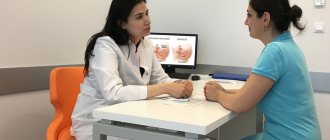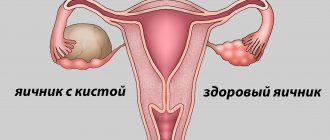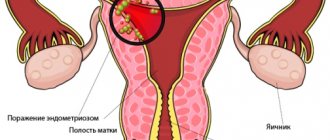What contraindications exist for endometriosis?
Endometriosis is a common gynecological disease affecting thousands of women.
To cope with the disease, it is important to clearly understand what is prohibited and what cannot be done so as not to aggravate the course of the pathology. Contraindications for endometriosis must be strictly taken into account. The disease can progress, and timely treatment completely solves the problem. It is worth considering whether, for example, playing sports is acceptable and how to properly organize your life in order to avoid negative health consequences.
Possible complications
Overheating the body in a bathhouse can become an impetus for the further development of endometriosis. The progression of the disease is expressed in the growth of foci and penetration into surrounding tissues, their subsequent destruction. Polyps and growths form.
- pain increases;
- bleeding increases;
- endometriotic formations increase in size over time, creating scars, adhesions or cysts.
After confirming the diagnosis, it is important to follow the doctor’s instructions and take into account the ban on thermal procedures. A responsible approach to treatment will help stop the progression of the disease.
Women with a hormone-dependent disease of the uterine cavity need to know what contraindications there are for endometriosis and under the influence of what factors the pathology can progress. Statistics show that 20 out of 100 patients of reproductive age have this problem. Endometriosis is included in the list of diseases that lead to infertility.
Under the influence of hormonal levels, the pathology progresses from one degree to another, causing the woman excruciating pain, accompanied by periodic massive bleeding. Therefore, together with conservative treatment or postoperative removal of lesions, it is important to follow the rules stipulating sports training, thermal procedures, diet and other life issues.
Contraindications for endometriosis
If a woman is diagnosed with endometriosis, it is important to listen to the recommendations of the gynecologist. After consulting your doctor, it will become clear how to cope with the disease.
But classical treatment for endometriosis is not always suitable for everyone. Some cannot take hormonal medications due to allergic reactions or individual intolerance, so we also advise you to read about alternative methods of treating endometriosis without hormones.
Conservative methods of treating inflammatory diseases of the uterus cannot be used in the presence of certain chronic diseases. Contraindications are diabetes mellitus and severe damage to the gastrointestinal tract.
For endometriosis and other pathologies and abnormalities of the uterus, self-medication is strictly prohibited. In some cases, doctors recommend surgical intervention, as they consider this method the only one possible for a complete recovery.
It is worth considering whether the following actions and procedures are allowed for a woman suffering from endometriosis:
It is better to ask your doctor what is possible and what is not. Some exercises for endometriosis can help speed up recovery, while others can be harmful. Balance is important in everything.
Is it possible to have a massage?
Professional massage for endometriosis is an opportunity to improve well-being and cope with some pathological processes. In the area of the uterus, with the right influence, adhesions begin to break down, blood circulation improves and nutrition of the organs of the reproductive system is normalized.
With cervical endometriosis, high-quality gynecological massage can reduce the severity of negative symptoms. The most effective technique is acupressure. As a result of the course of therapy, the woman will feel a decrease in pain, especially during menstruation.
You can’t trust inexperienced massage therapists to perform a massage. In order not to harm, but to improve the condition, the procedures must be carried out by a qualified specialist.
Sex and endometriosis
Sexual relations during endometriosis are not prohibited. The partner does not have to worry that he will become infected with this pathology, since it is not infectious in nature, is an exclusively female disease and cannot be transmitted.
Sometimes during sexual intercourse, unpleasant sensations can bother a woman. This is due to the growth of the endometrium and the inflammatory process inside the reproductive organs. More often, pain is less pronounced in the first half of the menstrual cycle.
Sometimes you need to refrain from rough contacts that involve deep penetration. It is worth refusing sexual intercourse if endometriosis is in a very advanced stage, and a woman often experiences vaginal uterine bleeding that is not associated with menstruation. By the way, in order not to confuse them with bleeding, we recommend reading about how menstruation occurs with endometriosis.
Thermal treatments
Therapy for endometriosis should not be combined with strong exposure to heat. The influence of high temperatures should be minimal, and sometimes completely eliminated.
Some women are interested in whether it is possible to go to the bathhouse. Taking baths with hot water or visiting saunas is strictly prohibited if you have endometriosis. The use of heat should not affect the area of the uterus, lower back, or abdomen. High temperatures provoke disease progression and complications.
Visits to the solarium and tanning are not strictly prohibited, but it is important to adhere to the following recommendations:
- do not sunbathe on very hot days - it is better not to go outside at all at this time;
- to drink a lot of water;
- do not change the climate sharply and often;
- sunbathe during the velvet season, when sun activity decreases.
As heat exposure increases, the risk of endometriosis progression increases. Although you can sunbathe, it is worth remembering that high temperatures provoke even more growth of the endometrium.
Danger of hypothermia
Diseases of the cervix and other parts of the reproductive system are negatively affected by both thermal exposure and hypothermia, as a result of which the disease can be complicated by cystitis and inflammation of the appendages.
You can't even steam your feet in very hot water. You can take warm foot baths and drink warm tea. You should not do anything that can increase the growth rate of the endometrial layer.
If you have endometriosis, you should not use tampons on your menstrual periods. These products interfere with the full release of menstrual flow, thereby increasing the risk of pathological reflux of blood into the peritoneum.
If your doctor prescribes, you can use medicated tampons. They are made using herbs and valuable extracts that have a beneficial effect on a woman’s health. Apply outside of critical days.
Types of baths and recommendations for visiting them
Baths and saunas are thermal procedures. In case of endometriosis, gynecologists exclude their visits. Each clinical case requires consultation with a doctor; the gynecologist takes into account the individual characteristics of the body and the stage of development of the disease. The following points are important:
- Russian bath. High humidity and temperature are maintained. This type is prohibited in case of illness. A long stay in the steam room is expected, which leads to overheating.
- Sauna. In a Finnish sauna, the humidity is kept low, but the air temperature reaches 100°C. Prolonged exposure can cause complications, so the sauna is prohibited for this gynecological disease.
- Hammam. The advantage of a Turkish bath is that it does not have a steam room. The temperature does not reach high levels, so the procedure is easily tolerated and has fewer contraindications in comparison with the Russian bath and sauna. If the attending physician gives permission to visit the hammam, you should be careful and avoid overheating, especially in the lower abdomen and lower back. Traditional massage in this establishment is not contraindicated for endometriosis, if it does not affect the areas where the foci of the disease are located, as it can provoke bleeding.
- Infrared sauna. Endometriosis is a contraindication to the procedure. This is due to deep heating of the body tissues.
- A water bath, which consists of taking hot baths, is excluded.
There are reviews on the Internet about visiting a bathhouse or sauna due to endometriosis. This is often done contrary to the doctor's recommendations. But in a number of situations, the procedure is agreed upon with the gynecologist and is carried out taking into account the recommended temperature regime and length of stay.
Features of the diet
Although there are certain contraindications, nutrition for endometriosis should be complete and balanced. Frequent meals are recommended, while the volume of food is small. It is important to reduce the amount of animal fats. If you are overweight, it is better to get rid of it.
It is important to drink at least 2 liters of clean water per day. Products containing fiber should be on the menu daily. It is better to eat fruits in the first half of the day. Fatty fish should be consumed at least once a week.
It is important to eat enough cereals, white meat chicken, and fermented milk products. A nutritious diet will help you maintain health and recover from pathology faster.
Now it has become clear whether it is possible to take a steam bath, visit a solarium and play sports. To avoid uterine bleeding and exacerbation of diseases, it is important to make adjustments to your lifestyle. He must be balanced - and this will help cope with the disease.
Is it possible to identify
Endometriosis is an insidious gynecological disease that can be asymptomatic for a long time . A hidden disease is often discovered accidentally during an examination for infertility.
Symptoms of the pathology resemble manifestations of other gynecological diseases.
The intensity can range from vague discomfort to unbearable pain. Some patients may experience fainting, nausea or vomiting.
Depending on the location of the lesion and the severity of the disease, pain of varying intensity may occur during bowel movements and intimacy .
With endometriosis, the menstrual cycle changes. Bleeding becomes more profuse and prolonged, and the cycle is often shortened.
A few days before the start of menstruation or a few days after, many patients experience spotting brown discharge.
This condition is difficult to treat with medication, and in severe cases leads to the development of posthemorrhagic iron deficiency anemia.
Hormonal imbalance and so-called burst uterine bleeding , quite characteristic of the diffuse form of the disease, aggravate the situation.
In some cases, symptoms of general intoxication may develop: increased body temperature, general weakness, fatigue, etc.
Endometriosis
The endometrium is the richly vascularized (permeated with blood vessels) mucous layer that covers the inner surface of the uterus. Endometriosis is a systemic pathological process in which cells of the endometrial layer spread beyond the uterus and, growing, form foci of the uterine mucosa in other parts of the body.
The prevalence of endometriosis has increased dramatically in recent decades. If in the middle of the twentieth century only specialists knew about this disease, today characteristic complaints are constantly heard at gynecologist appointments; the diagnosis itself, as they say, is becoming increasingly popular - and is increasingly attracting the attention of research medicine, since many questions remain unclear. There are also no exact epidemiological data: published approximate estimates vary from 6-7% to 50% of the general population of women. A number of authors consider endometriosis to be one of the most common gynecological diseases today, affecting women of the most active age (usually in the range from 20 to 40 years, although there are cases of much earlier manifestation). It is known that endometriosis is found in half of patients undergoing infertility treatment, and in the majority of women (up to 80%) with chronic pelvic pain. The Caucasian race is susceptible to this pathology to a greater extent than the other two.
To date, the etiopathogenesis remains unknown. Several main hypotheses are considered, discussed and confirmed (to varying degrees). Thus, a significant connection has been established between the likelihood of endometriosis and the number of traumatic gynecological procedures suffered. According to the “retrograde menstruation” hypothesis, the greatest risk factor is the reverse reflux of menstrual blood into the fallopian tubes. The possibility of degeneration of other tissues (eg, coelomic epithelium) into the uterine endometrium is being actively studied; This “metaplastic” hypothesis, in particular, explains the occasionally observed cases of endometriosis in men. In some sources, endometriosis is considered as a purely oncological (precancerous or intermediate) pathology, especially since endometrial cells are actually capable of metastasizing and growing into other tissues (for example, the walls of the bladder, skin, lungs, peritoneum, etc.). A number of facts indicate that harmful influences during prenatal development, hereditary predisposition (it is reported that with a family history of cases, a woman’s risk of developing endometriosis is up to five times higher than in the general population), hormonal disorders and imbalances, autoimmune mechanisms.
Perhaps endometriosis is a disease of a polyetiological nature, which is “triggered” by a certain combination of triggers under unfavorable internal conditions.
Symptoms
The most common and pronounced symptom of endometriosis is pain in physiological acts (urination, menstruation, coitus, defecation) and standard gynecological examination. Sometimes there are also cycle disorders, menorrhagia (abnormal heaviness of menstruation), and persistent nausea. As mentioned above, endometriosis can cause infertility and constant pain in the lower abdomen.
In general, the clinical picture depends on where exactly the proliferation (growth) of endometrial cells begins. Based on this feature, two main forms of the disease are distinguished: genital and extragenital. In the first case, areas of the endometrium are found on the ovaries, fallopian tubes, vagina and other structures of the reproductive system. Extragenital endometriosis (less than 10% of the total number of registered cases) can be localized, in fact, anywhere. However, in any case, well-being and symptoms depend on the phase of the menstrual cycle, since endometrial receptors respond to the appropriate hormonal “commands” and begin to bleed, which can easily lead to an inflammatory process.
The so-called adenomyosis (endometriosis of the uterine body), in which the mucous endometrial layer grows into the muscular space of the uterine wall; This situation is particularly difficult to treat.
According to the severity and prevalence of endometriosis, four stages are distinguished.
Diagnostics
Ultrasound of the pelvic organs (even with transvaginal access, which gives much more informative results) does not always allow visualization of characteristic changes, therefore the absence of signs of endometriosis on ultrasound cannot be considered as evidence of its actual absence. More accurate diagnostic methods in this case are certain types of x-ray examination (for example, hysterosalpingography), hysteroscopy, MRI - when using these studies, the probability of reliably detecting endometriosis, if it really exists, is 85-90%. Many sources, however, call diagnostic laparoscopy the most reliable way to detect endometriosis.
Description of the disease
What does endometriosis of the uterus mean? Endometriosis is a hormonally dependent systemic disease caused by the growth of the glandular layer of the endometrium outside the uterine cavity.
The course is long-term and recurrent. The mucous membrane of the uterine cavity (endometrium) consists of columnar epithelium and a connective tissue basal layer.
In the thickness of the endometrium there is a dense capillary network and tubular glands. In a healthy woman, such tissue is located only in the uterine cavity.
For unknown reasons, fragments of glandular tissue, structurally and functionally similar to the endometrium, can be found on the surface or in the thickness of the walls of organs, where they normally do not exist.
Such formations are called heterotopic.
This tissue is subject to the same cyclical changes as normal endometrium. During menstruation, heterotopic areas of the endometrium bleed, this condition is accompanied by pain.
With each cycle, the size of the pathological formation increases , and as the pathology progresses, other pelvic organs may also become involved.
Excessive sun exposure
During exposure to the sun, the female body begins to produce large quantities of the hormone estrogen, which is already in excess with endometriosis. Due to this, accelerated growth of endometrial cells begins, which leads to even greater growth of endometrioid lesions.
There are a number of recommendations for sun exposure in the summer:
- On the beach you should only be in the shade and go to cool rooms as often as possible;
- Drink enough clean drinking water;
- Avoid abrupt changes in climatic zones and visit hot countries only during the velvet season, since at this time the insolation is moderate.
If a woman is diagnosed with endometriosis, she is strictly contraindicated from visiting solariums.
Is it possible to play sports
Endometriosis and sports are compatible concepts. A woman can and should lead an active lifestyle. Various types of physical activity are allowed, including yoga.
Physical activity for endometriosis should not be excessive. The best option is training for half an hour up to 6 times a week.
With endometriosis, you can pump up your abs, walk a lot, and do physical exercises while lying on your back. When doing yoga, you should give preference to those exercises that strengthen the body as a whole, increase endurance and breathing. You should not do anything that increases blood flow to the pelvic organs, or exercises that put direct pressure on the peritoneum.
Therapeutic gymnastics, Pilates, and fitness are acceptable. You should avoid jogging, twirling a hoop, and various crunches. Any exercises with weights are not suitable for women with endometriosis.
Thermal treatments
Endometriosis has the following contraindications for the use of heat:
- Bath;
- Sauna;
- Mud therapy;
- Hot water baths;
- Heating pads for the lumbar region.
Due to the effect of heat on the area of the uterus and appendages, the growth of endometrioid lesions is possible. This will lead to an increase in the manifestation of all the symptoms of endometriosis: the pain will become more intense, and the amount of bleeding will increase.
Also, heat is strictly prohibited when endometriosis is combined with various benign or malignant neoplasms.
The impact of low temperatures on the pelvic area can lead to the development of inflammatory processes in the uterine cavity and in the appendage area. This can very seriously aggravate the course of existing endometriosis.
Therefore, women with such diagnoses are contraindicated: swimming in cold water, sitting on stones or cold surfaces. Also, in the winter season, you need to take care of your wardrobe: dress warmly and comfortably to avoid hypothermia.
General massage without the use of heat is not contraindicated for endometriosis. However, such a variety as vacuum massage (using cups) in the abdomen or lower back is contraindicated for use in this disease.
During this procedure, the jars are heated using an open fire, thereby exposing the female reproductive organs to heat. And this, as mentioned above, leads to the growth of foci of the disease and negatively affects the prognosis of treatment of this pathology.
The use of gynecological acupressure for endometriosis also raises many questions. It is not contraindicated for women, but only if it is performed by a qualified specialist in this field.
One of the main symptoms of endometriosis is that a woman is overweight. Therefore, the first thing you should pay attention to when starting treatment is reducing the consumption of harmful foods and maintaining the ratio of proteins, fats and carbohydrates.
It has also been proven that animal fats are a source of estrogen in the body, which is already elevated in patients with endometriosis.
Of course, it is impossible to completely eliminate these substances from the daily diet, since they are found even in lean meat. But it is worth limiting the amount of meat products you eat to 200 grams. in a day.
Also, the following foods are contraindicated for endometriosis:
- Coffee;
- Tea;
- Carbonated drinks;
- Chocolate in any form
- Bakery;
- Dairy products.
It is advisable to contact a professional nutritionist at the initial stage of treatment to create an individual diet.
The invention of hygiene products such as tampons has made a woman's daily life much easier during menstruation. However, these drugs are contraindicated for women suffering from endometriosis.
Due to blockage of the vagina with a tampon, menstrual blood does not flow properly, and it can flow back into the uterus or further into the fallopian tubes and pelvic cavity. This will lead to a new dispersion of endometrial cells and to their further ectopic growth.
Diagnostics
How to diagnose endometriosis of the uterine body, what tests and examinations are performed when making a diagnosis?
Symptoms of endometriosis are nonspecific and resemble manifestations of other gynecological diseases.
During a standard examination, the doctor may detect an enlarged uterus; in the nodular form, large nodes are palpated.
Asymmetry in the thickness of the walls of the uterus, an increase in the size of the organ, diffuse and nodular pathological formations in the thickness of the myometrium are revealed.
Colposcopic examination can identify lesions that have spread to the cervix.
Hysterosalpingography, an X-ray examination of the uterus, makes it possible to assess the patency of the tubes and the extent of lesions. It is carried out on days 5-7 of the cycle.
Early stages of endometriosis are detected during laparoscopic examination.
If the basic research is insufficiently informative, the patient may be prescribed an MRI or CT scan .
The study reveals the exact location and size of the lesions. If necessary, a histological examination is performed.
A blood test sometimes reveals an increase in ESR. The hormonal background differs from normal; patients show increased levels of luteinizing and follicle-stimulating hormones, prolactin with a simultaneous decrease in progesterone levels.
The most characteristic sign of pathology is an increase in the content of the specific marker CA-125 .
Mysterious endometriosis
If you delve into the anatomy of the female reproductive organs, you will find out that the inside of the uterine cavity is lined with a special tissue - the endometrium. It is he who receives the fertilized egg during pregnancy and ensures good blood supply to the zygote until the placenta is formed. If for some reason the endometrium begins to grow rapidly and extend beyond the organ, then doctors diagnose endometriosis.
If you delve into the anatomy of the female reproductive organs, you will find out that the inside of the uterine cavity is lined with a special tissue - the endometrium. It is he who receives the fertilized egg during pregnancy and ensures good blood supply to the zygote until the placenta is formed. If for some reason the endometrium begins to grow rapidly and extend beyond the organ, then doctors diagnose endometriosis.
When to see a doctor
Healthy people are recommended to undergo preventive examinations by specialized specialists annually.
In practice, a visit to a doctor is often postponed indefinitely and the patient ends up at the appointment when it becomes completely unbearable to endure.
It is better to be overly vigilant than to waste time.
Endometriosis is difficult to treat, and complete recovery is generally not possible.
Cases of spontaneous healing after childbirth have been described, but the likelihood of such a development is assessed as low.
After the decline of reproductive function, the manifestations of pathology disappear due to changes in the hormonal status of the woman. A comprehensive treatment program for uterine endometriosis is developed individually, based on the patient’s examination data.
In addition to the shape, location and severity of the lesion, the doctor takes into account the patient’s age and her ability to become pregnant in the future.
When the disease is first detected, conservative treatment is prescribed.
The course of conservative therapy includes:
- non-steroidal anti-inflammatory drugs;
- hormonal agents;
- sedatives;
- immunomodulators;
- vitamin-microelement complexes.
Additionally, a course of physiotherapeutic procedures is prescribed.
In advanced cases, in the absence of effect from conservative treatment, contraindications to the use of medications, the woman is prescribed combination or surgical treatment .
Surgical treatment can be radical or organ-preserving. Preference is given to laparoscopic surgical interventions, which involve local removal of foci of pathological endometrium.
After such an operation, a woman will not be able to have children , so the technique is used to treat women over 40 years of age, and in exceptional cases - at a younger age.
The success of treatment is determined by the preservation or restoration of fertility.
The criteria for recovery are the absence of subjective complaints and clinical symptoms of relapse for 5 years.
“Doctor I...” - Stage 4 endometriosis, laparoscopic surgery:
Endometriosis: causes and theory of occurrence
The theory of the occurrence of this disease has not yet been studied; no doctor can name the exact causes of the development of endometriosis. According to medical research and statistics, the main factors that provoke pathological growth of tissue outside the uterus are:
- hereditary predisposition;
- hormonal imbalance in the body;
- lack of regular sexual relations;
- previous abortions;
- diagnostic curettage of the uterus;
- previous surgical interventions on the uterus or its cervix;
- immunodeficiency states;
- chronic inflammatory processes of the pelvic organs;
- constant stress;
- autoimmune diseases.
Diagnosis of endometriosis
The prognosis of the disease largely depends on how promptly the patient sought medical help and began treatment. The diagnosis is made based on the results of a comprehensive examination, including:
- Bimanual examination of the uterus and its appendages on a gynecological chair (the initial examination includes collecting an anamnesis of the woman’s life);
- Colposcopy of the cervix (performed in the last days of the cycle, several days before the expected menstruation, thus, the results of the study will be the most informative);
- Examination of the uterine cavity using a special device - a hysteroscope, equipped at the end with an optical system;
- Ultrasound examination of the pelvic organs;
- MRI;
- CT scan;
- Blood tests for tumor markers.
Diagnostic research methods also include laparoscopy. A huge advantage of this procedure is the ability to simultaneously remove pathological areas, thereby restoring the normal functioning of the reproductive organs.
Depending on the research results, the patient is prescribed effective treatment - conservative or surgical. When advanced endometriosis is detected in young women, doctors try to preserve the ovaries and uterus, since the patient still has to give birth in the future. If the disease is diagnosed in people of menopausal age and the pathology only progresses, then the question arises of removing the uterus.
Why is endometriosis dangerous?
If endometriosis is not treated in a timely manner, then as the pathology progresses, severe complications develop that are difficult to treat. The most common of them are:
- infertility. Read about whether IVF is possible for endometriosis;
- iron deficiency anemia – develops against the background of heavy menstruation and becomes chronic;
- the formation of adhesions in the fallopian tubes, intestines, bladder, which is accompanied by pain in the lower abdomen and dysfunction of these organs;
- degeneration of the pathological process into uterine cancer.
Can endometriosis be cured?
Without exception, all women diagnosed with endometriosis are concerned with the question: can this disease be cured? Unfortunately, it is impossible to completely get rid of this pathology, but it is possible to achieve remission of the disease, that is, stop the progression and further proliferation of cells. To do this, a woman must carefully follow all the doctor’s instructions and eliminate factors that provoke endometriosis. Read more about the treatment of endometriosis.
Is it possible to sunbathe and go to the sauna with endometriosis?
This question is of great concern to women who are accustomed to taking care of their body and skin. Thermal procedures, in particular staying in the sun or in a bath (sauna), increase blood flow to the pelvic organs. This can lead to the progression of endometriosis and aggravation of the disease; in addition, ultraviolet rays often provoke the degeneration of this pathology into uterine cancer. Considering these factors, gynecologists do not recommend that women with endometriosis visit baths and saunas, or spend a long time on the beach under the sun or in a solarium.
Treatment of inflammatory processes of the uterus
There are several methods to eliminate this pathology.
Low frequency current pulses
Not many people know that pulsed current has a sedative and analgesic effect. For example, electrophoresis using iodine allows it to be administered in small dosages. In this case, this substance can remain in the skin for up to three weeks, and then gradually enters the plasma. If this method is used correctly, iodine should accumulate in the pelvic area over time, which is of great importance for chronic types of disease. Iodine itself stimulates the entire regeneration process. In addition, under the influence of iodine, hormonal levels and the balance of the pituitary gland are normalized. However, you should know that current cannot be used if the patient has gallstone disease. An excellent way to fight against inflammatory processes of the uterus. It also has analgesic, anti-inflammatory, and stimulating effects. Magnetic therapy is aimed at eliminating tissue swelling and pain; the highest magnetic permeability ensures the passage of magnetic fields to any tissue depth, which is quite important for complex surgical interventions. Magnetotherapy normalizes the functioning of the central nervous system and also improves blood circulation. As a rule, it first causes a spasm of the capillaries (short-term), and then expands the capillaries of the veins and speeds up the wound healing process. Laser therapy also has an anti-inflammatory and bactericidal effect, reduces tissue swelling, and activates metabolism in the area of the inflammatory process. If combined with laser and Magnetotherapy, the therapeutic effect is much better. But doctors recommend using this method only after the early postoperative period. In common parlance, this means taking iodine-bromine baths, and the doctor can simultaneously use vaginal microenemas with radon water along with this technique. The clinical effect of such baths is pain relief, inhibition of inflammatory processes, normalization of hemodynamics in the pelvic area. This treatment, according to many doctors, is the most effective, and the course of therapy is approximately 4 months. In addition, iodine-bromine waters have virtually no side effects, there are no contraindications, they are used even for hyperestrogenism. A very good therapy, it fights various kinds of diseases, but this technique has contraindications that are worth mentioning. First of all, it should be said that climatotherapy is absolutely contraindicated in hyperestrogenism; ultrasound and various currents are also incompatible with this method of treatment.
Be that as it may, before choosing one of the treatment methods, you need to weigh the pros and cons, and only then make a decision. It would be a good idea to take all the tests completely and then you can go to the doctor with them. Even if you have such an unpleasant illness, you should not give up. Fight for your health, follow all the doctor’s recommendations and then you will definitely become healthy!
Lifestyle
Prevention and treatment of any disease includes a number of general recommendations for promoting health.
How to live with endometriosis, what can and cannot be done with this diagnosis?
Diet and nutrition
There are no specific dietary restrictions ; it is enough to adhere to general recommendations for a healthy diet. Food should be complete and varied.
You can enrich it with fruits, vegetables; uncrushed cereals, seeds and some types of nuts are useful.
There is no need to limit your meat consumption, but it is better to replace some meat products with sea fish.
Bath, sauna, beach
Is it possible to visit the bathhouse if you have endometriosis, go to the sauna or take sunbathing?
It is believed that thermal procedures contribute to the progression of endometriosis , however, the presence of a diagnosis is not an absolute contraindication.
If visiting a sauna, bath or bath leads to a deterioration in your health, then it is better to abstain from them.
This question should be asked to your gynecologist, who monitors the dynamics of the disease, and follow his recommendations.
Whether it is possible to sunbathe with endometriosis largely depends on the specific clinical case. If a doctor recommends abstaining from sunbathing, you should ignore his recommendations.
The symptoms and causes of the development of adrenal adenoma in women are discussed in this material.
You can learn about the treatment of chronic bladder inflammation in women here on the website.
Sports and physical activity
An active lifestyle has never been harmful , provided that the loads are feasible and training does not cause a deterioration in well-being.
Physical exercise reduces estrogen levels in the blood. When choosing a sport for yourself, it is advisable to consult a doctor.
Is it possible to have sex
Once diagnosed, doctors recommend abstaining from intimacy during menstruation .
Contraception methods
One of the methods of treating endometriosis is hormone therapy . Oral contraceptives are prescribed for therapeutic purposes.
Is it possible to insert an IUD for endometriosis? The intrauterine device is considered to be a factor that provokes the development of the disease, so the decision on the possible installation of a therapeutic IUD is made individually, taking into account the characteristics of the clinical case.
Contraindications
Women with diagnosed endometriosis should avoid tampons . They can impede the flow of blood, which increases pain and provokes the progression of the disease.











